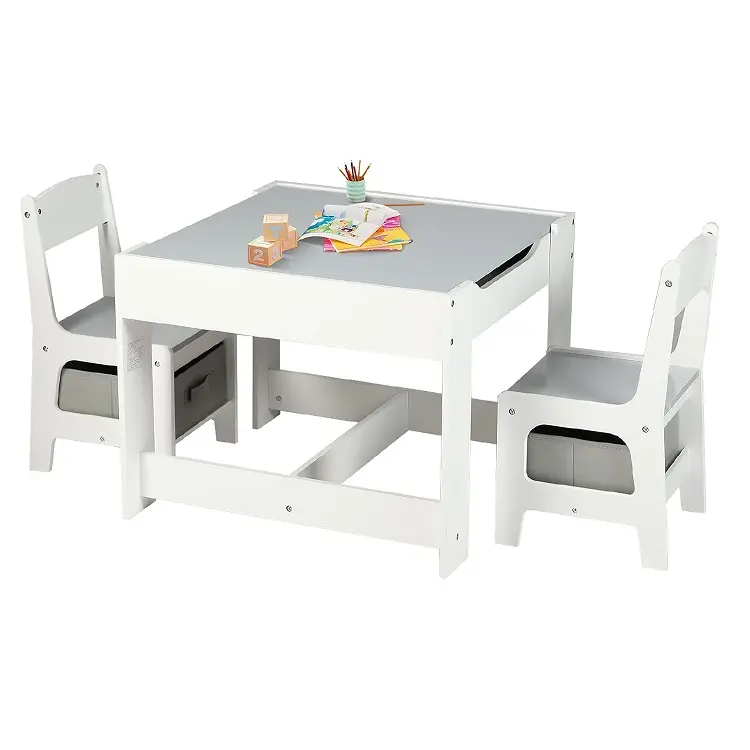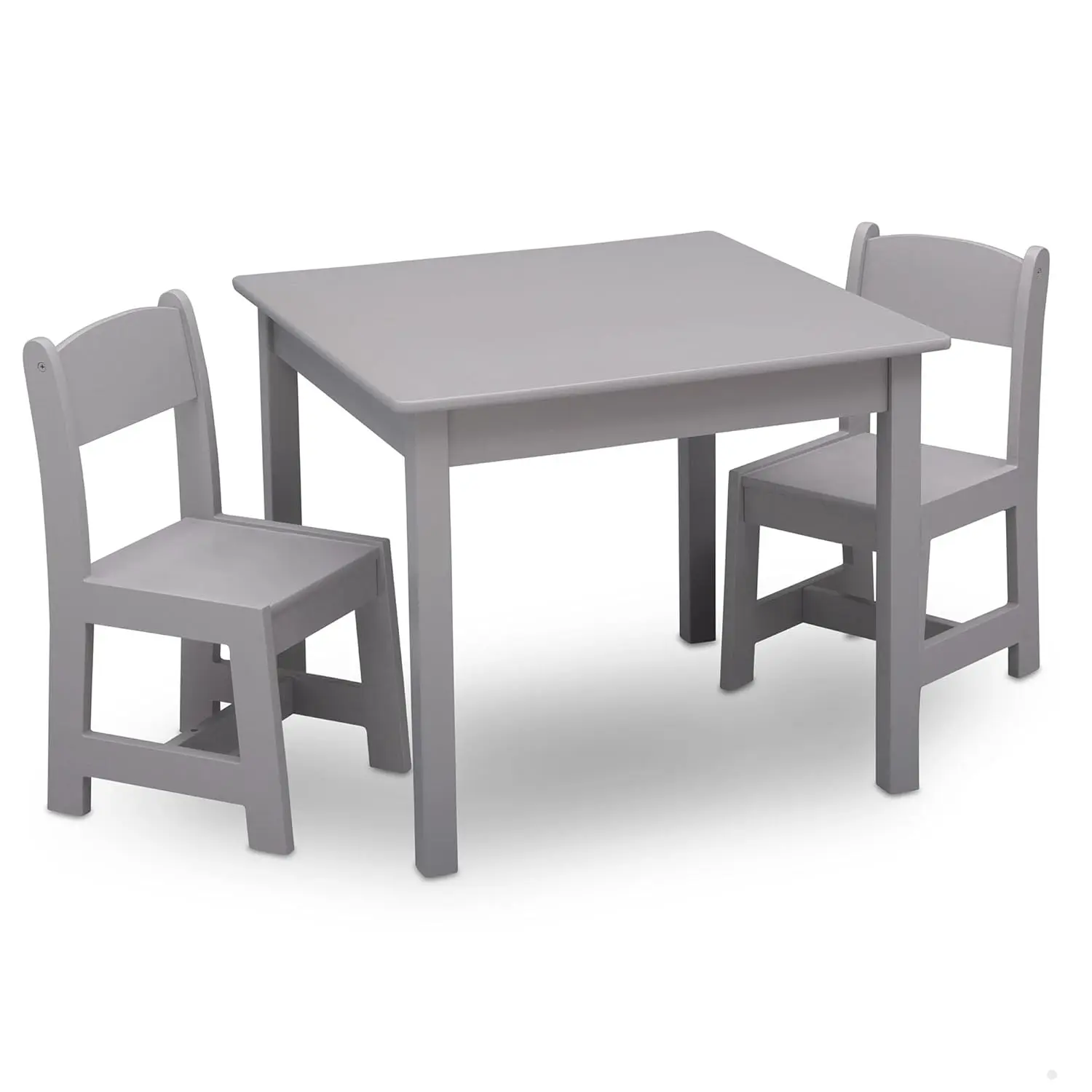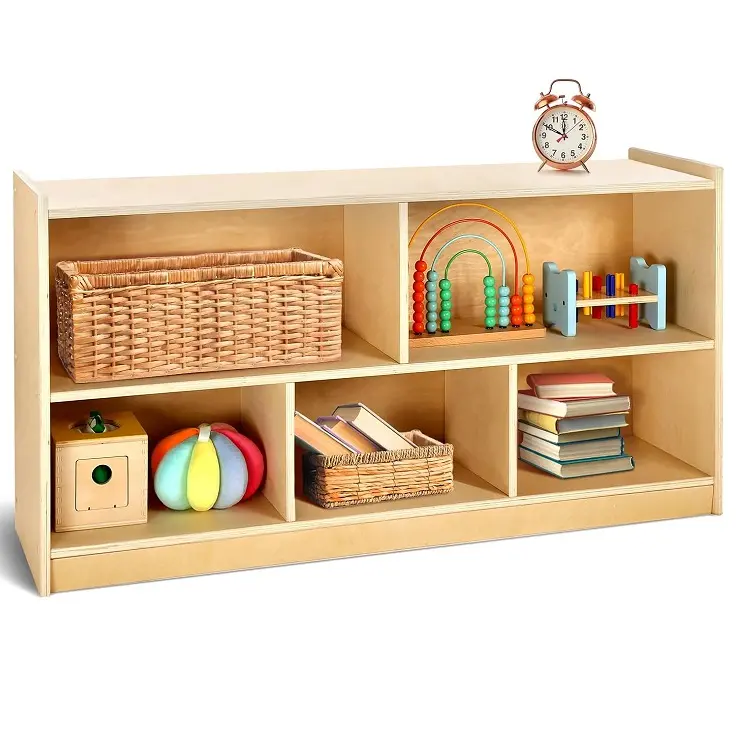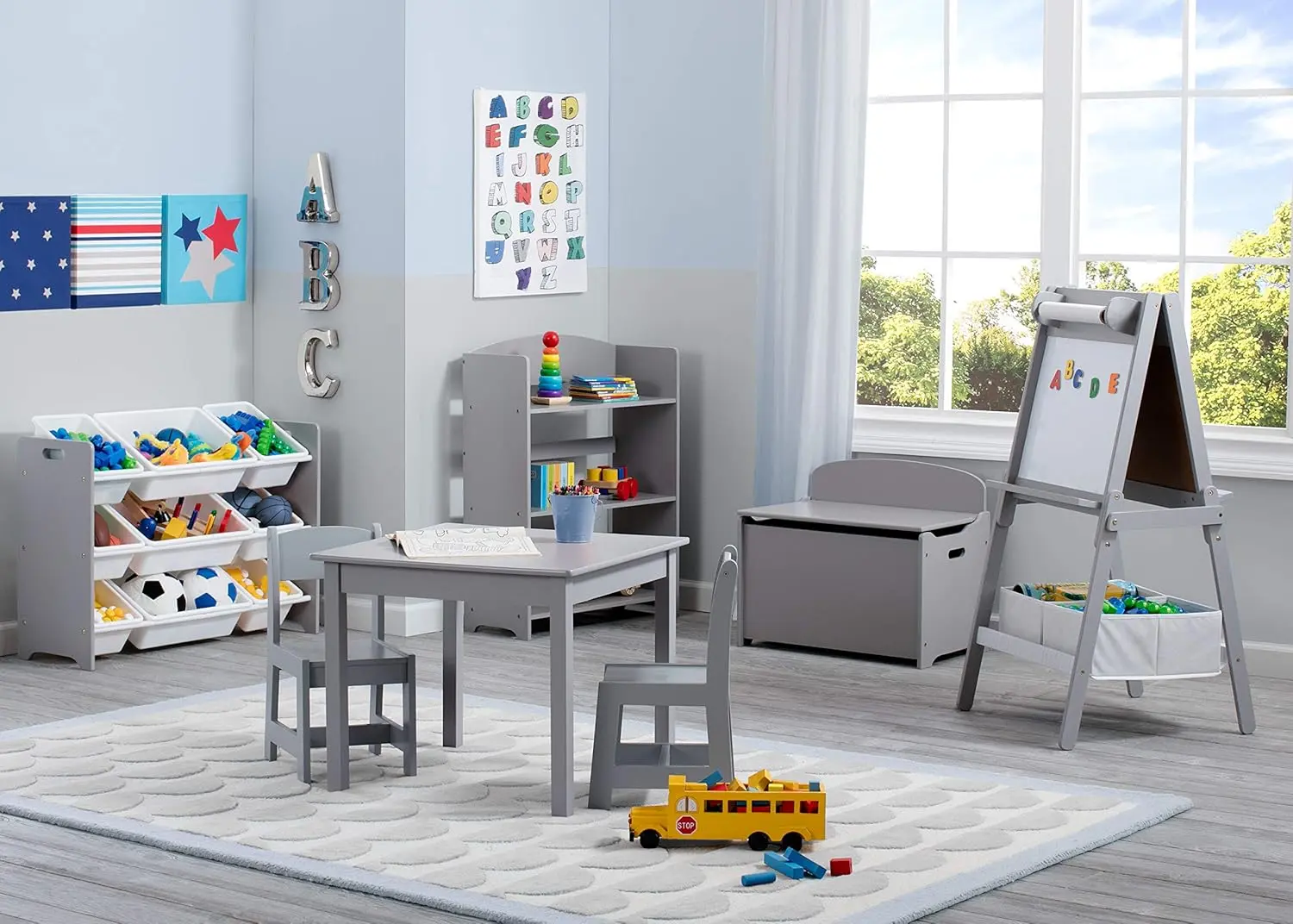Creating the perfect space for your kids is about more than just picking out cute items; it's about designing environments where they can safely play, learn, and grow. This article is your guide to choosing kid-friendly furniture that's not only stylish and fun but also safe, durable, and perfectly suited for bedrooms and playrooms. We'll explore everything from essential furniture pieces to clever design tips, ensuring you create spaces your children will adore and you'll feel good about. Read on to discover how to furnish rooms that spark imagination and stand up to the everyday adventures of childhood.
1. What Essential Furniture Pieces Do Kids Need in Their Bedrooms?
When furnishing a kid’s bedroom, think about the essentials that cater to their daily activities: sleep, play, study, and storage. The most important piece of furniture is definitely the bed. For toddlers transitioning from a crib, a toddler bed or a twin bed with safety rails is a great start. As they grow, you might consider bunk beds or loft beds if space is limited or if they share a room. Bunk beds are fun and space-saving, perfect for siblings or sleepovers. A sturdy bed frame is crucial for safety and mattress support, ensuring a good night's sleep for your little one.

Next, consider storage. Kids accumulate a lot of things! A dresser is essential for clothes, and a bookcase or bookshelf keeps books and toys organized. Toy storage units, like bins and baskets, help manage clutter and make tidying up easier. A desk is important as they start school, providing a space for homework and creative projects. Don't forget a comfortable chair for the desk too! For younger kids, a small table and chairs set is perfect for art projects or tea parties. These furniture pieces form the foundation of a functional and kid-friendly bedroom, making it a comfortable and organized space for your child. Think about adding a Children's Bookcase & Toy Organizer to keep everything tidy.
2. Where Can You Find the Best Kid-Friendly Furniture for Bedrooms and Playrooms?
Finding the best kids’ furniture involves looking at a few key places. Specialty children’s furniture stores are a great option because they focus specifically on furniture designed for kids. These stores often carry brands that prioritize safety and kid-friendly features like rounded edges and non-toxic materials. Department stores and large retailers also have kids furniture sections, offering a variety of styles and price points. Online marketplaces are another avenue, providing a vast selection and the convenience of shopping from home. Websites often have customer reviews, which can be helpful in assessing the quality and durability of the furniture pieces.
For budget-friendly options, consider stores like IKEA, which offers a range of furniture designed for kids that's both affordable and functional. Local furniture stores can sometimes offer unique, solid wood pieces that are built to last. Flea markets and consignment shops are worth checking out for vintage or gently used kids furniture – you might find unique items at great prices. When choosing furniture, regardless of where you shop, always prioritize safety, durability, and kid-friendly features. Look for furniture made from non-toxic materials and with rounded corners. Think about how the furniture will fit into your room design and meet your child's needs.
3. Nursery Furniture Essentials: What Do You Need to Furnish a Safe and Cozy Nursery?
Setting up a nursery for your little one is an exciting time, and choosing the right nursery furniture is key to creating a safe and cozy space. The most essential piece is the crib. Look for a sturdy and safe crib that meets current safety standards. Convertible cribs are a popular choice because they can transform into a toddler bed and even a full-size bed as your child grows, offering longevity and value. A comfortable changing table is another must-have, providing a safe and convenient spot for diaper changes. Many changing tables come with built-in storage, which is incredibly useful for keeping diapers, wipes, and lotions within reach.

A cozy glider or rocking chair is essential for feeding and soothing your baby. This will become your go-to spot for late-night feeds and cuddles. Storage is also crucial in a nursery. A dresser for baby clothes and a bookshelf or bookcase for books and toys will help keep the nursery organized and functional. Consider adding a rug to soften the floor and add warmth to the room design. Soft lighting, like a dimmable lamp, creates a calming atmosphere. When selecting nursery furniture, always prioritize safety. Ensure the crib meets safety standards, changing tables are stable, and all furniture pieces are made from non-toxic materials. Creating a safe and cozy nursery is about choosing the right furniture that meets your baby's needs and provides comfort for you too.
4. What is Nugget Furniture and Why is it Becoming a Popular Kid-Friendly Choice?
Nugget furniture, often simply called a "Nugget," is a type of modular play furniture that's become incredibly popular for kid-friendly spaces, especially playrooms. It's essentially a set of soft, foam pieces – typically four cushions in different shapes – that can be reconfigured into countless creations. Kids use Nuggets to build forts, tunnels, slides, chairs, and anything else their imaginative minds can dream up. The appeal of Nugget furniture lies in its versatility and ability to encourage imaginative play. It's not just furniture; it's a toy that stimulates creativity and physical activity.
The kid-friendly design of Nuggets is another major draw. They are made from soft, comfortable foam and covered in durable, easy to clean fabric, often with removable and washable cushion covers. This makes them perfect for playroom furniture as they can withstand the rough and tumble of kids’ play and spills are easily managed. Nuggets are also relatively lightweight and easy for kids to move around and reconfigure themselves, fostering independence and problem-solving skills. While Nuggets can be pricier than some other furniture options, their versatility, durability, and the amount of play they inspire often make them a worthwhile investment for families looking to create a dynamic and engaging kid-friendly space. They are a fantastic example of furniture that grows with a child's imaginative needs.
5. How to Choose Furniture That Grows with Your Kids, Ensuring Longevity and Value?
Choosing furniture that grows with your kids is a smart way to furnish their rooms, ensuring longevity, versatility, and good value for your money. Convertible cribs are a prime example of this. Starting as a crib for a baby, they can transform into a toddler bed, then a twin bed, and sometimes even a full-size bed. This means you’re investing in one piece of furniture that serves multiple purposes throughout your child’s early years, rather than buying new furniture at each stage.

Modular furniture is another excellent choice for furniture that grows. Modular shelving units can be reconfigured as storage needs change. A low bookshelf for a toddler can become a taller bookcase as they get older and their book collection expands. Desks with adjustable heights are also fantastic. A desk that can be raised as your child grows ensures they always have an ergonomically comfortable workspace, promoting good posture and productivity. When furnishing a child’s space, look for pieces that offer this kind of adaptability. Opting for furniture made from durable materials like solid wood also contributes to longevity. While these pieces might have a higher upfront cost, their ability to adapt and last for many years makes them a cost-effective choice in the long run. Furniture that grows is not just about saving money; it’s about creating a sustainable and adaptable environment for your kids. You can find durable Solid Wood Table and 2 Chairs Set that will last for years.
6. Is Nursery Furniture Different from Furniture for Older Kids, and How to Transition?
Nursery furniture is specifically designed for babies and very young toddlers, focusing on safety and infant-specific needs. Key pieces like cribs and changing tables are essential in a nursery but become unnecessary as kids grow. Cribs, by design, are enclosed for safety, while furniture for older kids is more open and focused on functionality for play, study, and storage. Changing tables, while incredibly convenient for babies, are outgrown quickly. Nursery furniture often features softer colors and themes, creating a calming atmosphere suitable for infants.
As your child grows into a toddler and then a school-aged kid, their needs change dramatically, and so should their bedroom furniture. The transition typically starts around 2-3 years old when a toddler bed replaces the crib. This is often followed by introducing a dresser, bookcase, and a small table and chairs set. As they enter school, a desk becomes essential for homework and study. The style of furniture also evolves. Furniture for older kids can incorporate bolder colors, themes reflecting their interests, and designs that encourage independence and organization. The transition from nursery furniture to furniture for older kids is a gradual process. Furniture pieces like dressers and bookcases can often be reused, especially if they are in neutral styles. The key is to adapt the furniture to meet your child’s changing needs and preferences while always keeping safety in mind.
7. Is IKEA Furniture a Good, Budget-Friendly Option for Kid-Friendly Spaces?
IKEA furniture is a popular and often budget-friendly option for kid-friendly spaces, offering a wide range of styles and functional designs. One of the main advantages of IKEA is its affordability, making it accessible for many kids’ rooms where furniture might need to be replaced more frequently due to wear and tear or changing tastes. IKEA’s kids furniture lines are designed with functionality in mind, often incorporating clever storage solutions and modular designs that are great for smaller spaces. Their furniture is also generally easy to clean, a practical benefit for kids’ rooms where spills and messes are common.
However, when considering IKEA for kid-friendly spaces, it's important to assess durability. While IKEA furniture is budget-friendly, some pieces might not be as robust as solid wood furniture and may show wear and tear more quickly, especially with active kids. Safety is another key consideration. IKEA furniture generally meets safety standards, but it’s always wise to double-check specific product details and assembly instructions to ensure safety, particularly for items like bunk beds and dressers that need to be securely assembled and potentially anchored to the wall. Overall, IKEA furniture can be a good option for kid-friendly spaces, especially if you’re looking for budget-friendly, functional, and stylish pieces. Just be mindful of durability and always prioritize safety when assembling and using the furniture. For example, IKEA offers various storage units that can be great for kids' rooms. (Note: This is an external link, not an internal link from the JSON).
8. Room Design Ideas: How to Layout a Kid-Friendly Bedroom and Playroom for Functionality and Fun?
Designing a kid-friendly bedroom or playroom layout is about creating a space that is both functional and fun, catering to your child’s needs for play, rest, and learning. Start by zoning the space. In a bedroom, designate areas for sleeping, studying, and playing. Place the bed in a comfortable and calming area, away from direct sunlight if possible. Position the desk near a window for natural light, creating a productivity zone. Incorporate a play area with a rug and toy storage to keep toys contained and the space organized. For a playroom, think about activity zones – perhaps a reading nook with comfy pillows and a bookshelf, an art area with a table and chairs, and an open space for active play.

When planning the layout, consider traffic flow. Ensure there’s plenty of space for kids to move around freely and safely without bumping into furniture. Keep walkways clear and avoid placing furniture in high-traffic areas. Use furniture to define different zones within the room design. For example, a bookshelf can subtly separate a reading area from a play area. Think vertically for storage. Utilize wall-mounted shelves and tall bookcases to maximize storage without taking up valuable floor space. Don't forget to add personal touches that make the space feel like your child’s. Incorporate their favorite colors, characters, and artwork into the décor. A well-planned layout makes the room design functional, safe, and a delightful space for your child.
9. What are the Advantages of Modular Furniture in Kid-Friendly Room Design?
Modular furniture offers significant advantages in kid-friendly room design, primarily due to its versatility and adaptability. Modular systems are composed of individual units that can be arranged and rearranged in various configurations, offering flexibility as your child’s needs and the room design evolve. For instance, modular shelving units can start as low, accessible storage for a toddler and be expanded vertically as they grow and require more storage space. This adaptability makes modular furniture truly furniture that grows with your kids.
Another key advantage is space efficiency. In smaller kids’ rooms, modular furniture can be configured to fit the available space perfectly, maximizing functionality without overcrowding. Modular storage units can be customized to fit specific needs – drawers, shelves, and cabinets can be combined to create tailored storage solutions for toys, books, and clothes. Modular furniture also encourages creativity and engagement. Kids can participate in rearranging the units to suit their play or study needs, fostering a sense of ownership and control over their space. From a practical standpoint, modular furniture is often easier to transport and assemble compared to large, fixed pieces. Its versatility, space efficiency, and adaptability make modular furniture an excellent choice for creating dynamic and functional kid-friendly spaces.
10. How to Arrange Kids Furniture to Keep Everything Within Reach and Encourage Independence?
Arranging kids furniture to keep everything within reach is essential for fostering independence and making the space truly kid-friendly. The goal is to create an environment where children can access their belongings easily and safely without constantly needing adult assistance. Start by positioning frequently used items at lower levels. For example, place toys and books on lower shelves of bookcases or in toy storage bins that are easily accessible from the floor. Hang clothes rods in wardrobes at a height that allows your child to reach their clothes independently.

Use step stools safely when needed to reach higher shelves, but primarily focus on arranging items so that step stools are minimally required for everyday tasks. Furniture designed with built-in accessibility features, like dressers with lower drawers and bookcases with bottom shelves, are ideal. When setting up a desk area, ensure the desk and chair are at the right height for your child. Keep desk supplies within reach using desk organizers and drawers. Involve your child in the organization process. Ask them where they want things to be placed so that it makes sense to them and is easy for them to access. Creating a space where everything is within reach empowers kids, promotes self-sufficiency, and makes their room a truly kid-friendly and functional environment. Consider a Wooden 2 Step Stools for Kids for safe reaching.
11. How to Ensure Plenty of Space for Play and Activities in a Kid's Room Design?
Ensuring plenty of space for play and activities is paramount in a kid’s room design. A cluttered and cramped room can stifle creativity and limit physical activity. The first step is to declutter ruthlessly. Regularly go through toys, books, and clothes with your child and donate or remove items that are no longer used or needed. This immediately creates more usable space. Choose furniture that maximizes vertical space and minimizes floor footprint. Bunk beds or loft beds are excellent for freeing up floor space in bedrooms, creating room for a play area or desk underneath. Wall-mounted shelves and tall, narrow bookcases provide storage without taking up valuable floor space.
Opt for furniture with built-in storage. Beds with drawers underneath, ottomans that double as storage, and benches with storage compartments help keep clutter at bay and maintain open space. Modular furniture, as discussed earlier, can be configured to fit the room’s dimensions and can be rearranged as needed to optimize space. Keep the center of the room design as open as possible. Avoid placing large pieces of furniture in the middle of the room, which can break up the space and make it feel smaller. Use rugs to define play areas without visually dividing the room. Mirrors can also create an illusion of more space, making the room feel brighter and larger. By thoughtfully selecting and arranging furniture and prioritizing open space, you can create a kid’s room design that has plenty of space for play, creativity, and comfortable living.
Key Things to Remember When Furnishing Kid-Friendly Bedrooms and Playrooms:
- Essentials First: Start with a bed, storage (dresser, bookcase), and a desk (for older kids).
- Safety is Key: Prioritize furniture with rounded edges and non-toxic materials.
- Durability Matters: Choose durable materials like solid wood for longevity.
- Storage Solutions are Crucial: Incorporate ample storage to keep rooms organized and spacious.
- Furniture That Grows: Consider convertible and modular furniture for long-term value and adaptability.
- Room Layout: Zone the space for sleep, play, and study, ensuring clear traffic flow.
- Keep it Within Reach: Arrange furniture so kids can easily access their belongings, fostering independence.
- Maximize Play Space: Declutter regularly and choose space-saving furniture to ensure plenty of play area.
- Budget-Friendly Options: IKEA and similar stores offer affordable and functional kid-friendly furniture.
- Personalize the Space: Involve your child and incorporate their interests into the décor.
By keeping these tips in mind, you can create kid-friendly bedrooms and playrooms that are not only beautiful and fun but also safe, functional, and perfectly tailored to your child’s needs and dreams.
Post time: Feb-10-2025





